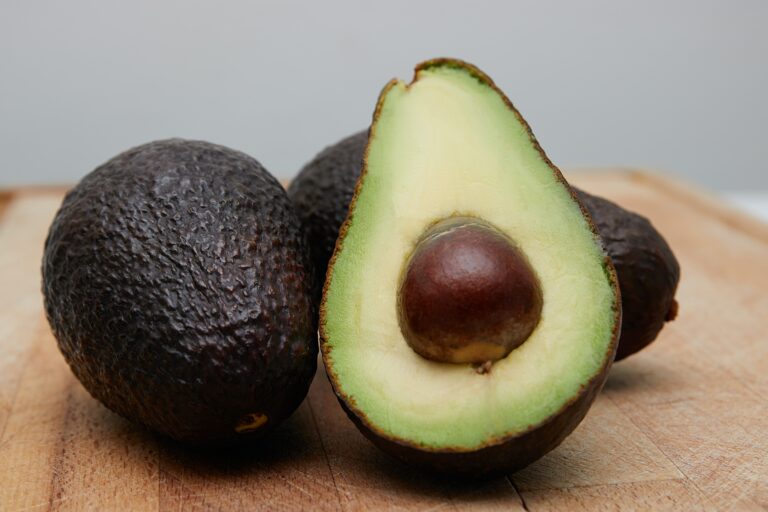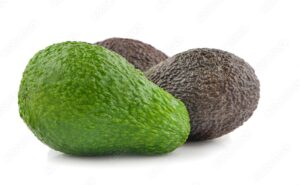Food and Nutrition Education Resources
Veggie Spotlight: Avocado!
By: Jaz Popa, 11/17/2022

What are Avocados?
Avocados, also known as alligator pears, are a creamy, delicious, nutty-tasting fruit that are in the Lauraceae family, related to the cinnamon tree! Avocados are high in fiber, potassium, heart-healthy fats, vitamin E, and plant–based protein. Although their exteriors are typically bumpy, the flesh is rich, smooth, and buttery. They can be enjoyed savory but are also commonly used in desserts.
How to Tell When Avocados are Ripe:
When avocados are ripe, their skin will be a very dark green-brown and feel slightly soft when squeezed. An unripe avocado will have skin that is a lighter or brighter green color and will feel hard when squeezed. If you need to ripen an avocado, store it at room temperature by a window. If you want the unripe avocado to ripen even faster, store it with an ethylene gas producing fruit, like a banana. Some produce, like bananas, emit ethylene gas that can cause other fruits to ripen faster. Click the button below to see a complete list of ethylene–producing and sensitive foods. You can store the avocado next to the banana, or in a paper bag together to get it to ripen even faster. Be cautious of this, however. This can cause the avocados to ripen very quickly and sometimes go bad before you remember to use them!

Left: unripe avocado
Right: ripe avocado
How to Store Avocados:
Avocados can be stored at room temperature on the counter or in the refrigerator. If the avocado is very ripe, store it in the fridge to prevent it from going bad too quickly. If it is unripe, store it at room temperature. If the flesh of the avocado is exposed, be sure to store it in the fridge in an airtight container. Avocado flesh that is exposed to air can turn brown, called enzymatic browning. Although many people find the brown avocado flesh unappetizing, it is perfectly safe to eat.
To prevent enzymatic browning, try one of the following:
– Cover the flesh with a squeeze of lemon or lime juice.
– Wrap it tightly with plastic wrap so that no flesh is exposed to air
– Store it in a sealed, airtight container.
– Store an avocado half with some sliced onion in a sealed airtight container; the sulfur compounds in the onion help preserve the avocado.
– Store the leftover avocado with the pit.
How to Process Avocados:
Avocados can be tricky to peel and cut. Check out the directions and video below on how to safely process an avocado.
1. Wash.
2. Cut lengthwise. *Optional: Rotate 90 degrees and cut lengthwise again.
3. Separate each segment.
4. Squeeze out the pit. Do not use a knife. Instead, place your index and middle finger on the flesh on each side of the pit, placing your thumb behind the avocado on the skin; push into the center with your thumb until the pit pops out.
5. Peel each segment.
6. Slice, dice, mash, or enjoy whole!
How to Freeze Avocados:
Since avocados can go bad in the blink of an eye, freezing them is a great way to prevent food waste and save your food dollars. If you see that your avocado is on the brink of being a little too ripe and you don’t anticipate using it before it goes bad, freeze it! Avocados can be frozen whole, in halves, diced, or even mashed. However, if you are freezing it whole, be sure to freeze it when it is ripe. Unthaw your frozen avocados like you would anything else, or use them frozen in a smoothie for a creamy, nutritious boost! Click the button below to learn the step-by-step processes for freezing all forms of avocados and recipes for using frozen avocado.
How to Prepare Avocados:
Avocados are delicious whole, diced, mashed, as dressings, or as desserts! You can top any meal with avocados to add creaminess to a crunchy meal or coolness to a spicy one. You can blend avocado with a neutral oil, fresh herbs, dried seasonings, and acids like lemon juice or vinegar to make a dressing or dip. Mashed avocados can be used in place of mayonnaise. Avocados can also be enjoyed in desserts and baking. Add them to smoothies or puddings to create nutrient-dense thickness and richness. Pureed avocado can be substituted for butter or oil in baking recipes using a 1:1 ratio (1 cup butter = 1 cup avocado). Avocados are a versatile, amazing fruit. So don’t be afraid to get creative and use them in new ways!
Click the buttons below to find new ways to enjoy avocado.
